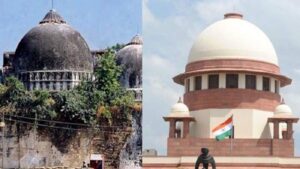
A new Covid-variant appears to have considerably subdued Ayodhya-wave. Yes, Indian headlines are being dominated by threat of third Covid-wave being triggered in the country by the new variant- Omicron. Nevertheless, attempts being made by several politicians to gamble on Ayodhya-issue cannot be ignored. These include new train services for pilgrimage to Ayodhya. Frankly, at present, most Indians seem to be least affected by “panic” on both fronts- Ayodhya as well as Omicron. At least, this is marked by their minimal impact on what is known- Big Fat Indian Wedding Season. Weddings and related celebrations marked for December 6, the preceding weeks and the coming month have, according to sources, not been affected. Rather, statistics indicate a gigantic business worth several trillion rupees being engaged in for these weddings.
Communal drive in recent era displayed its worst phase when riots took place in most parts of India over the controversial Ayodhya issue, following demolition of Babri Masjid in Ayodhya, Uttar Pradesh on December 6, 1992. Even during that phase, it would be wrong to assume that each and every Indian Hindu and Muslim was involved in communal rioting. Rather, a greater percentage chose to abstain from the same. A decade later when Gujarat carnage took place, it is noteworthy that it was primarily confined to this state only. During this period, people in other parts were not provoked to similar communal rioting despite reports of Gujarat carnage being telecast. Clearly, this conveyed a strong message. It was not easy to weaken secularism of Indian community throughout the country.
Interestingly, the post-Gujarat carnage phase has not been witness to any other state being engulfed by communal crisis of a similar nature. Undeniably, attempts have been made to provoke people over various issues in the name of religion. But they have failed to have any major impact of negative nature. Yes, history has been witness to mobs indulging in communal rioting with colonies of targeted people’s houses and shops being burnt down. At the same time, it cannot be ignored that recent phase has not been witness to history of this nature being repeated. Communal incidents of present period have primarily involved a few individuals, in few cases, dozens targeting one or two individuals.
Of late, attempts have been made by certain individuals to prevent Muslims from reading Friday prayers at few public places in Gurugram, neighboring capital city, New Delhi. Criticism levied at right-winged individuals indulging in such behavior must also be taken note of. Equally important is offer of a Hindu of his premises for Friday prayers and similar offer made by Sikhs of their places of worship, Gurdwaras. Communal incidents at Gurugram have been in news since September. The hard reality of such incidents taking place as crucial elections approach cannot be ignored.
Ayodhya-issue can no longer be viewed as a communal bomb that it once seemed to be. Against this backdrop, what can politicians gain by playing upon their religious moves regarding Ayodhya? Of course, constitutionally, they have as much right to be as religious they desire. After all, India is a multi-religious, secular country. Besides, most politicians indulge in display of their religious as well as secular images for political gains. Almost all key leaders, including Prime Minister Narendra Modi, flaunt their “secularism” by sending a token symbol to Ajmer Shareef every year. When it is election time, substantial importance is given by most in the race to gain media coverage of their visiting temples and so forth. Well, this is India.
Modi is apparently well aware that he cannot afford to openly use communal card for political gains. It is not without reason that he donned the secular mask when he first chose to join national politics by contesting 2014 parliamentary elections. Also, each time communal frenzy targeting minorities of some nature, particularly Muslims, hits headlines, protests and demonstrations against it do not take long to surface. A greater number of secular, non-Muslims (largely Hindus) participate in these demonstrations than Muslims. This suggests that question of Ayodhya gaining any communal angle among people at large is as good as non-existent.
Successive decline in nature and frequency of communal rioting cannot be missed. Those who still remain pessimistic about success of Indian secularism need to pay serious attention to this reality. Yes, there lurks a fear that failure of concerned politicians and officers to take strong action against extremist, communal elements is likely to encourage the latter to continue with lynching activities as and when it pleases them. Well, over past two decades, protests against the same through various means of communication have certainly indicated that Indians are not going to keep quiet about communalism of this nature. The manner in which secularism has frequently raised its head only indicates that it should not be expected to bow down before communalism.
On one hand, religious importance being given by various politicians to Ayodhya cannot be ignored. These Ayodhya-moves cannot but be viewed as strategy being exercised by various politicians to apparently enhance their image and of course “religious” credentials in eyes of Indian voters. Considering that these moves are being indulged in when the vicious virus is sending distress signals from all directions and several crucial state elections are approaching, they are probably hopeful that Ayodhya-move will be of some help in distracting people’s attention. Will it? This may be viewed as a million dollar question by politicians but irrelevant as rudimentary survey indicates for people at large!
